#Document Collection Software
Explore tagged Tumblr posts
Text
Boost Your Business Efficiency with Moxo Workflow Automation Tool
In today’s competitive business environment, efficiency and speed are essential for success. A workflow automation tool can help organizations automate routine tasks, streamline operations, and enhance team collaboration. Among the leading solutions on the market, Moxo stands out as an innovative and user-friendly workflow automation tool designed to optimize business processes and improve overall productivity.
What is a Workflow Automation Tool?
A workflow automation tool is software that automates repetitive business processes by defining a series of steps—called workflows—that are triggered automatically to complete tasks without manual intervention. These tools eliminate bottlenecks, reduce errors, and ensure consistency across all operations, from simple approvals to complex multi-step projects.
Why Choose Moxo as Your Workflow Automation Tool?
Moxo combines powerful automation capabilities with an intuitive interface, making it ideal for businesses of all sizes. Here’s why Moxo is the preferred workflow automation tool for many:
1. Easy Workflow Design
Moxo offers a drag-and-drop workflow builder that allows users to create, customize, and automate processes without technical expertise. This empowers teams to implement automation quickly and adapt workflows as business needs evolve.
2. Integrated Communication and Document Management
Moxo is not just a workflow automation tool; it also excels as document collection software, enabling businesses to securely collect, manage, and share important documents within automated workflows. This integration simplifies compliance, onboarding, and other document-heavy processes.
3. Secure and Compliant
Security is a top priority at Moxo. The platform features enterprise-grade encryption and compliance with key industry regulations, safeguarding sensitive business information and customer data throughout the workflow.
4. Real-Time Tracking and Analytics
Moxo provides real-time visibility into every step of your workflows. With detailed analytics and reporting, businesses can monitor performance, identify delays, and continuously optimize processes.
Benefits of Using Moxo Workflow Automation Tool
Adopting Moxo’s workflow automation tool brings significant advantages:
Save Time: Automate routine tasks and approvals to free up your team for higher-value work.
Reduce Errors: Automation minimizes human error, ensuring tasks are completed accurately.
Enhance Collaboration: Centralize communication and document sharing for seamless teamwork.
Improve Customer Experience: Faster and more consistent workflows lead to better service delivery.
Simplify Document Handling: As top-tier document collection software, Moxo streamlines the gathering and organization of critical documents, saving time and reducing manual follow-ups.
Scale with Ease: Moxo’s flexible platform grows with your business, handling increased complexity effortlessly.
Who Can Benefit from Moxo?
Moxo’s workflow automation tool is suitable for various industries, including:
Financial Services: Automate client onboarding, KYC checks, and compliance workflows.
Healthcare: Streamline patient intake, referrals, and documentation.
Real Estate: Manage contracts, inspections, and transaction processes efficiently.
Professional Services: Optimize project management, invoicing, and client communications.
Getting Started with Moxo
Moxo offers a smooth onboarding experience with dedicated support and training to help your team implement workflow automation quickly and effectively. Whether you’re a small business or a large enterprise, Moxo adapts to your workflow needs.
Conclusion
Choosing the right workflow automation tool can transform the way your business operates. Moxo delivers a powerful, secure, and easy-to-use platform that automates processes, enhances collaboration, and drives efficiency. As leading document collection software, Moxo also simplifies the handling of critical documents within your workflows, making your operations even more seamless.
Discover how Moxo can help you automate workflows and take your business productivity to the next level.
0 notes
Text
Document Collection Software | Collect Bulk Documents & Data
DocuTick.com allows you to collect list of Documents and Data from your clients. Request Documents to your clients, collect and manage Documents on our portal. Accept or Reject Documents and store on DocuTick or Sync it into could Apps.
#Document Collection Software#Collect Bulk Documents and Data#Document Collection Software from client#Document Management Software#Secure Document Collection Software#Automated Document Collection Platform
1 note
·
View note
Text

Struggling with Outdated Processes & Inefficiencies? We’ve Got Your Solution!
Start the year strong with AssociationREADY’s Cloud-Based Solutions—designed to streamline your operations and put you back in control. Our industry-leading software is built specifically for the HOA industry, helping you automate, organize, and simplify everything from collections and case management to resale document processing.
ReadyCOLLECT – The ultimate HOA collection & case management platform for law firms, attorneys, and management companies. Whether you're a small practice or a large firm, RC2 helps you consolidate, organize, and streamline your collections & covenant violation processes with ease.
ReadyRESALE – Your one-stop solution for community document automation. Easily manage resale packages and association documents with just a click—no setup or maintenance fees required!
Why Wait? Upgrade your office with powerful, flexible, and efficient solutions tailored to your needs. Schedule a demo today and discover how AssociationREADY can transform your business: https://bit.ly/2xEyx1o
#AssociationREADY#CloudBased#HOA#Software#Solutions#PropertyManagement#LawFirms#Attorneys#Community#Associations#ReadyCOLLECT#ReadyRESALE#Collections#Document#Automation#CovenantViolations#ResalePackages#KnockDown
0 notes
Text
Exploring the Key Features of Loan Documents Collection Software
Introduction:
In the fast-paced world of lending, efficiency, accuracy, and compliance are paramount. Loan documents collection software revolutionizes the way financial institutions gather, verify, and manage the essential documents required for loan processing. In this blog, we will delve into the four key features that make loan documents collection software an indispensable asset in the lending industry.
Streamlined Document Gathering with Loan Documents Collection Software
Loan documents collection software simplifies the process of acquiring essential documents from borrowers. It automates requests for financial statements, tax returns, identification, and other necessary paperwork, minimizing the need for manual follow-ups.

Document Verification and Compliance Checks
This specialized software often incorporates integrated verification tools to ensure the legitimacy and accuracy of collected documents. It assists lenders in adhering to regulatory compliance requirements while also mitigating the risk of fraudulent submissions.
Secure and Encrypted Document Storage
Loan documents collection software offers a secure repository for storing sensitive borrower information. Documents are stored in encrypted formats, guaranteeing their confidentiality. They are readily accessible for review, audit, and reference as needed.

Real-Time Progress Tracking and Notification System
Lenders can monitor the status of document collection in real-time using loan documents collection software. The software sends notifications to both borrowers and lenders, keeping all parties informed about missing documents or outstanding requirements. This proactive approach expedites the loan approval process.
Conclusion
Loan documents collection software, with its automated document gathering, robust verification and compliance checks, secure document storage, and real-time progress tracking, not only simplifies the lending process but also ensures that lenders and borrowers alike can navigate the lending journey with confidence.
#loan documents collection software#best document collection software#Accounting documents collection#Loan documents collection#Clients documents collection#Credit documents collection#collect documents online
1 note
·
View note
Text
Writing Tools for Planning Your Story
I've tried tons of writing apps and sites, so you don't have to. Here's a list of free sites to plot out your novel, with my review and some images of how I use it.
Milanote
Milanote is like having a giant pinboard with folders. You can upload anything onto it [yes even your main doc] and then draw over it or connect things with lines and arrows
Milanote lets you add up to a hundred things for free, not including drawing. This is one of the downsides of the site as I've found myself reaching that limit recently.
For me, the best part is being able to draw over stuff, and the color swatches.
Milanote is a lot less structured than other sites I've used, and personally, I don't think their templates are worth using.
8/10 overall, Milanote is what I mainly use. Here are some pics of how I use it:
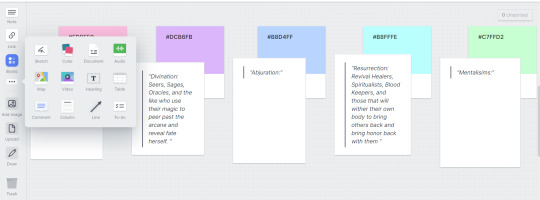
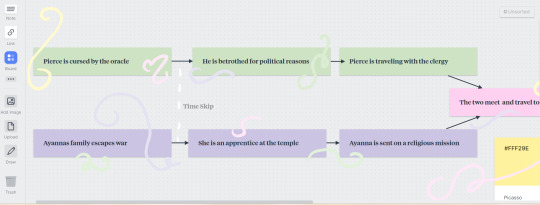
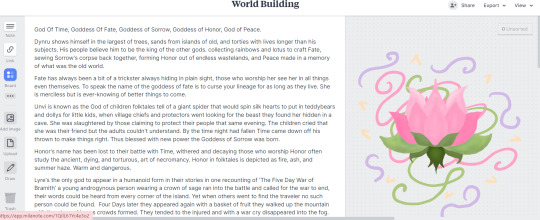
Miro
Miro is a flowchart website mainly used for corporate jobs, however, it can be a great plotting tool for that reason
Miro has a lot of great starter templates if you are looking for a more structured freeform experience. It also comes with a blank page as well.
Unfortunately, I'd argue that it's a bit of a hard tool for beginners to use without a template, I've learned copy-paste is my best friend with Miro the hard way.
It's much better than most platforms at making timelines though.
It has a limit of three boards which is a bit disappointing but overall, I think it's worth the try.
5/10 Miro is very middle of the road for me due to the limited ability to customize things and the free limit. Here are some pics:
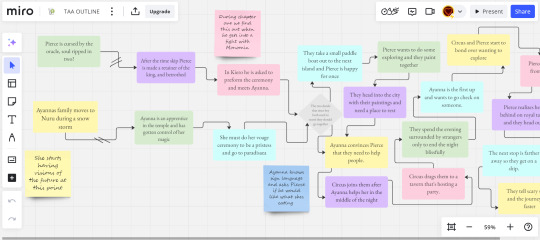

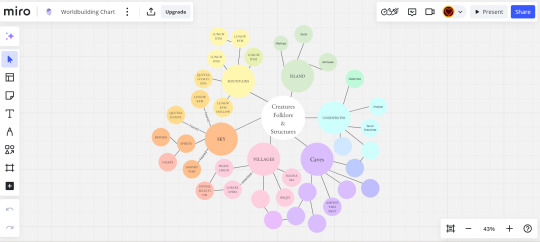
[I wrote that part weeks ago, I am now fully using Miro and believe it's the best for making timelines and charts, I just wish it let me make more boards 8/10]
Hiveword
This might be someone's jam, I can't really say it's mine though.
First off, the unpaid version is really just a few boxes saying "Write a summary here." which makes it just not worth it in my opinion
There really isn't any way to customise things which is my favorite part of most of these softwares
I've barely used this, so maybe there's something I'm missing but
1/10, Just use Google Docs at this point, here's a couple pics
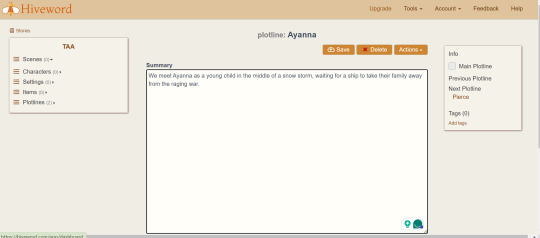

World Anvil
People like this software, it's mainly used for tabletop, which is just a different way of writing adventure, and I've seen it recommended by authors.
Unfortunately, I'm going to disagree with a lot of people and say it's hard to use and isn't even really good at plotting.
I may be biased on this one as every time I've tried to use it in the past I've struggled. However, it seems like another just write it in a document and create a folder.
I'd say it's closer to an organizing tool, but even then just use something else.
3/10, I have nothing to say about it but maybe you'll enjoy it, all here are two photos
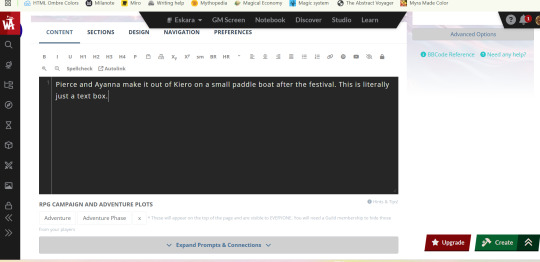

Campfire
This is the one I think I've heard the most about, but have never actually tried.
right off the bat, I'm going to say this is 100% worth it, you'll see at the end with the photos but this is like if Miro and World Anvil had an organization baby.
It's extremely easy to understand, and it makes timelines, it's more for writing your whole book but idk about that yet.
7/10, its themes are really pretty but it limits how much you can do to 20 I believe. Here are the photos
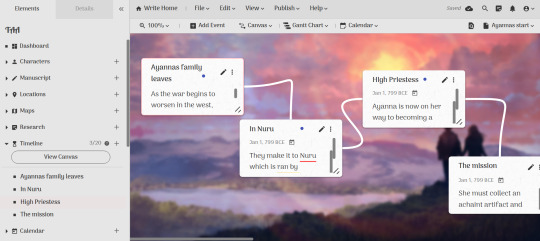
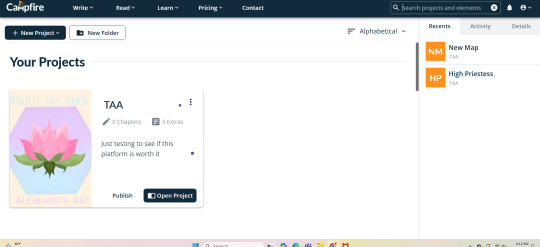
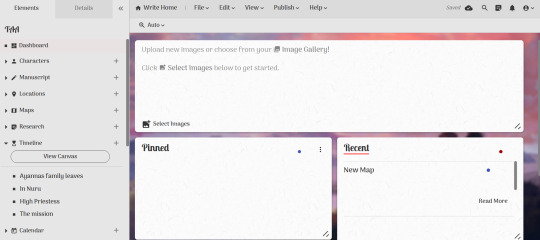
That's all for now, honestly, I think you should use Miro if you are looking to plot things out, and Milanote if you want to collect and organize your thoughts for writing, as that's what I do. Obviously what I like won't be for everyone, but hopefully, this helped you see some options
#writeblr#writers on tumblr#creative writing#worldbuilding#plotting#writing advice#writing tool#writing#writers#writing plans
1K notes
·
View notes
Text
Greek Mythology Sources
Interest in greek mythology rises anew with the new number of retellings and adaptions...and misconceptions all around...
Claims like "that never happened" or "that's the roman version" are around a lot...but even if you wanted to learn more, where would you even start looking? Where do you begin your research for your next fic, or next discussion? Well...That's for you!
Here's a list of source names, links to access them, maps, family trees & more
Where to access the texts:
ToposText
Database, interlinks all names and places, has almost all sources translated, can find all name mentions of place or character in the sources, has a map with the places
Perseus Collection Greek and Roman Materials (and Scaife Viewer)
Digital Library, nearly all main greek and roman sources, including OG language text and dictionary for those languages (is instable at times, try coming back a few hours/days later and it should be up again)
Theoi Greek Mythology
Database, has summary posts for individual heroes, creatures, gods and events, as well as many translations, has a search function
List of Ancient Sources
Homer's Iliad (8th BC)
Homer's Odyssey (8th BC)
Epic Cycle (and Theban Cycle) fragments (8-6th BC)
Homeric Hymns (7th BC)
Orphic Hymns (2nd BC/2nd AD)
Quintus Smyrnaeus’s Posthomerica (3rd AD)
Tryphiodorus’s Taking of Ilium (3rd AD)
Apollonius Rhodius’ Argonautica (3rd BC)
Nonnus’ Dionysiaca (5th AD)
Hesiod’s Theogony, Works and Days, Catalogue of Women (8th BC)
Statius’s Thebaid, Achilleid (1st AD)
(More under cut)
Virgil’s Aeneid (1st BC)
Valerius Flaccus’s Argonautica (1st AD)
Colluthus’s Taking of Helen (6th AD)
Pindar’s Odes (5th BC)
Plays by Sophocles, Aeschylus, Euripides (5th BC)
Fragments of lyric poets (8th-6th BC)
Athenaeus’s Deipnoshists (2nd AD)
Lycophron’s Alexandra (3rd BC)
Pausanias’s Description of Greece (2nd AD)
Strabo’s Geography (1st AD)
Scholia on Homer (~ 5th BC - 11th AD)
Scholia on Pindar (2nd AD?)
Scholia on Sophocles, on Euripides (1st BC-15th AD)
Maurus Servius Honoratus’ Commentaries on the Aeneid (5th AD)
Corpus Aristotelicum (4th BC)
Fragments of Hellanicus’s works (5th BC)
Diodorus Siculus’s Bibliotheca Historica (1st AD)
Herodotus’s Histories (5th BC)
Dionysius Halicarnassius’s Roman Antiquities (1st BC)
Plutarch’s Quaestiones Graecae (1st AD)
Eustathius’s commentaries on Homer (12th AD)
Apollodorus’ Bibliotheca, Epitome (2nd AD)
Hyginus’s Fabulae (2nd AD)
Ovid’s Works (1st AD)
Antoninus Liberalis’s Metamorphoses (2nd AD)
Conon’s Narrations (1st AD)
Dictys Cretensis (4th AD)
Dares Phrygius (5th AD)
Malalas’s Chronography (6th AD)
St.Jerome’s Chronicon (4th AD)
Eusebius’s Chronography (5th AD)
Philostratus the Athenian’s Heroicus (3rd AD)
Seneca Plays (1st AD)
Suda (10th AD)
Tzetzes (12th AD)
Duris of Same (4th BC)
Ptolemy Hephaestion (2nd AD)
More Sources:
WordHoard
(Software/Java Document for Scholia on Homer, commentary on the Odyssey & Iliad)
About This Book – Euripides Scholia: Scholia on Orestes 501–1100
Scholia on Euripides
LacusCurtius • A Gateway to Ancient Rome
Roman Sources and History
https://web.archive.org/web/20050625081727/http://sunsite.berkeley.edu/OMACL/Hesiod/iliad.html
Little Iliad Fragments
Most of these places have older translations for the epics, poems and hymns (with older language), places like Poetry In Translation and https://www.gutenberg.org often have newer translations available for free, though…with a bit of digging most translations even recent ones can be found online :)
Comparing several translations is also good if you want to make any arguments about what a text says without being able to read the text in the original language, does the text really say that or is it just this translation?
It also doesn't hurt to research a little about the author of a work as well to get context for which time and sociopolitical and personal situation they were writing in (it helps to do a quick search into the history of ancient greece too, i.e. epic writers writing during the 7th century BC had different agendas than playwrights of the 5th century during the persian wars, athenians during the conflicts with sparta, or later hellenistic writers after Alexander the Great)
Wikipedia: CAN be used, it's a good starting point, but check the sources cited as much as you can, rather than believing what the page itself says
Links to Maps
Ancient Greece Maps – Ancient Greece: Φώς & Λέξη
User:MaryroseB54 - Wikimedia Commons
Cyowari - Professional, Digital Artist | DeviantArt
Some of the Realms of Greece in the Heroic Age by Yaulendur on DeviantArt
Late Bronze Age Mediterranean Trade, c. 1400-1200 BCE: Empires, Merchants, and Maritime Routes of the Ancient World - World History Encyclopedia
Translators:
Translate to Ancient Greek Online
https://logeion.uchicago.edu
Wiktionary
Ancient Art
Resources
Harvard Art Museums
Family Tree:
(Compiled by a friend, not exhaustive) - Note that there are often various different versions of lineage for many characters, so this only represents ONE of many possibilities)
Family Echo
Books
Oxford classical dictionary.pdf
Brief History Of Ancient Greece.pdf
168679208-Ancient-Greece.pdf
Complete Greek Drama
The Ancient Epic Cycle and it's ancient reception A companion.pdf
Final Note
These things should not be gatekept, its time to share them freely
I wish I could offer even more sources via academic books and papers but I fear this would exceed my abilities considering the vastness of the topic of Greek Mythology! But this is a starting point :D Have fun!
Google Scholar has a lot of secondary sources (scholia commentary & theories), books about history, society, politics, flora & fauna, religion, culture, etc. of the time both of history and mythical history…if you have a friend in academia with university access (if you don’t have it yourself) you can ask them to check if they have access to the papers/books otherwise hidden behind insane paywalls, because a LOT of them are available as pdfs!
I also wish I had more visual/audio sources but this is smth I cant change :") I'm sure there's some good videos on youtube out there...somewhere x)
Feel free to contact me if you have more sources you want to add or any links don't work
Here is the Post as DOCs to share outside of tumblr
#greek mythology#tagamemnon#epic the musical#resources#ancient greek mythology#song of achilles#sorry for the long post
220 notes
·
View notes
Text
Using Sims2Pack Clean Installer with The Sims 2: Legacy Collection (and Ultimate too!)
Bringing over a simple (and previously documented) tutorial on how to make Sims2Pack Clean Installer work with Sims 2 Legacy and UC. This is just an adapated version of SimsWiki's UC FAQ, so all credit goes to them. If you want a written step-by-step, please go to their website! STEP 1: Download Sims2Pack Clean Installer

Download (and install) Sims2Pack Clean Installer. This tutorial will be covering the installable version, but the NoInstall one probably works the same. STEP 2: Open the Sims2Pack Clean Installer configuration file

You will now go into the directory where you selected and installed Sims2Pack Clean Installer on. By default, it installs on the C:/ drive, so it is probably located at C:\Program Files (x86)\Sims2Pack Clean Installer. That may vary if you changed the directory.
Open the file called "S2PCI.ini". That is the configuration file that we will be altering. PS: You can use your computer's default Notepad for this, but software like Notepad++ can be easier to manage/edit.
STEP 3: Edit your Sims2Pack Clean Installer configuration to detect Sims 2 Legacy/UC

Where it says SaveGamePath="", you will add the directory where your game's Documents folder is in between the "", just like shown in the photo. - For The Sims 2: Legacy Collection, it is usually C:\Users\YourUserName\Documents\EA Games\The Sims 2 Legacy - For The Sims 2: Ultimate Collection, it is usually C:\Users\YourUserName\Documents\EA Games\The Sims 2™ Ultimate Collection
After that, simply save and replace the file. Depending on your computer settings, it might say it is not able to save. If this happens to you, simply save the edited S2PCI.ini on your desktop, then copy and paste the file inside the Sims2Pack Clean Installer folder and replace the original file (and it should always ask for you to replace the original file! check the tips below for clarification). It might ask for administrator permission, just click yes and proceed until the file is replaced with the one you just edited.

TIP: Not sure what your username is? Simple: on your File Explorer, go to Documents > EA Games > The Sims 2 Legacy (or Ultimate Collection) and click the bar. It will show the full path to the folder. Copy that path and follow the rest of this step. TIP 2: Make sure to save it as a .ini file and NOT a .txt one! If you are having difficulties with that, go to File > Save as on Notepad and select "All Files (*)" as file type. Make sure to also name it exactly as S2PCI.ini (it SHOULD ask you to replace the original file, if it did not, something is wrong. Try following the steps again making sure everything was properly followed!)
STEP 4: Install your Custom Content

The last step is to install your custom content. To make sure that Sims2Pack Clean Installer is working properly with the configuration file you edited, make sure that it shows the path written in the file when you press install. It should point to the game's Documents folder like the image above. Now that you showed the program where your Sims 2 Documents folder is, it should auto-detect where to put the files. Ta-da! Your Sims2Pack Clean Installer is done and working. Enjoy your Custom Content and Sims2Pack installing galore all you want <3
#ts2#sims2#ts2legacy#legacycollection#thesims2#the sims 2#the sims 2 legacy#sims 2#sims 2 legacy#ts2cc#sims2cc#s2cc
288 notes
·
View notes
Text
🌸 Soft Pink Intro Loading Screen Override for SIMS 3
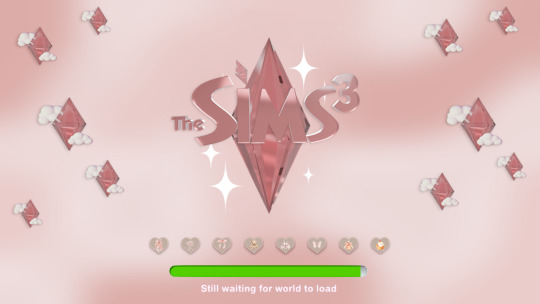
Tired of the boring sims 3 loading screen when you first open your game? Are you looking for a much more girly loading screen? I present to you a coquette inspired intro loading screen override, perfect for those who love a more pastel and girly vibe. More info & download links under the cut!
🍰INFORMATION
♡ This override will replace the default loading screen no matter which pack you installed last.
♡ You can only have ONE intro loading screen at a time
♡ This loading screen might look slightly different depending on your monitor and gshade/reshade. This screenshot was taken without any shaders.
♡ Compatiable with version 1.69.47.024017
♡ Ensure to always read my TOU
♡ Credit has been given to the relevant users/softwares
🍰WHERE TO PUT IT
⚠ MUST BE PUT IN THE OVERRIDES FOLDER ESPECIALLY IF YOU HAVE A UI RECOLOR
Documents > Electronic Arts > The Sims 3 > Mods > Overrides (or anywhere you have your sims 3 mods folder)
🍰DOWNLOAD
🌸Soft Pink Intro Loading Screen
🌸Patreon (alt)
Feel free to tag me if you use this override in your game, I'd love to see it! And if there is any problems don't hesitate to contact me <3
🍰CREDITS
♡ This interface was HEAVILY inspired by the USE YOUR HEART collection by @novabytesims for sims 4!
♡ I used the CLEAN UI LOADING SCREEN by @justmiha97 as the base for this loading screen so it's basically a recolour 🤭
♡ RawPixels for the icons you see in the hearts
♡ Blender 3.6, Photoshop 2021
🍰Terms Of Use (TOU)
♡ PERSONAL USE ONLY: My original cc & overrides are free for personal use in you Sims 3 game. DO NOT redistribute or claim as your own.
♡ CREDIT OF USAGE: If you share my cc in any way, please credit me.
♡ NO PAYWALLS: DO NOT put my cc behind any paywalls or adlinks such as linkvertise.
♡ REDISTRIBUTION POLICY: DO NOT reupload my cc on other sites. Please share my original download links to respect work put into my cc and spread the word.
♡ MODIFICATIONS: If you edit or recolour my cc, and want to share it, please give full credit where it's due.
#cozykhuwa cc#sims 3 cc#sims 3 custom content#sims 3 mods#sims 3 loading screen#ts3#ts3 simblr#ts3 cc#sims3cc#overrides
257 notes
·
View notes
Text
My Open-Source Tolkien Studies Data Sets
One of the best parts of being an independent scholar is that I get to be generous with my research. I am not counting on it for a job, and frankly, between teaching at a small rural school and running the Silmarillion Writers' Guild, I will likely never be able to do all that I want to do with the data that I collect and so love the idea that someone might do something with it.
Because I do love making sets of data. Everything from the mind-numbing copy/paste data entry to learning new spreadsheet formulas is enjoyable to me. I'm an introvert in a very extraverted profession, and after a day of being all on for my students, turning everything into numbers is like a cup of tea under a warm blanket with a Golden Retriever at my feet.
So please use these data sets if they interest you. Play with them. Write about and share what you notice. Expand and build on them. Publish using them. If you use my data or work, credit Dawn Walls-Thumma and link to my website, dawnfelagund.com, if possible. I'd also love if you'd let me know if you share anything using them.
Consolidated Timelines. I made this back in 2013. I was trying to arrange all of Tolkien's timelines side by side. I did some weird things with numbers that I'm not sure I fully understand now, but maybe you can make sense of this or maybe you just want everything Tolkien said about timelines in one handy document. (Make a copy of the Consolidated Timelines.)
Fanfiction Archive Timeline. Made for the 2023 Fan Studies Network North America conference, this timeline-on-a-spreadsheet shows archives in the Tolkien and Harry Potter fandoms, multifandom archives, and social networks and when they came online, were active, became inactive, and went offline, along with data about affiliated communities, software, and rescue efforts. I update this timeline annually with that year's data and will continue to add new archives when I have enough data to do so. (Make a copy of the Fanfiction Archive Timeline spreadsheet.)
References to Sources in the Works of J.R.R. Tolkien. In this document, I record each time a narrator's source is mentioned or alluded to. Ideally, this will one day include The Hobbit and The Lord of the Rings as well! For now, it is just The Silmarillion for the selfish reason that I'm predominantly a Silmarillion researcher. (Make a copy of the References to Sources.)
Silmarillion Characters. A list of all of the characters in The Silmarillion, demographic data about them, the number of times they are mentioned, various aliases, and which "books" of The Silmarillion they appear in. The latter part is a work-in-progress. (Make a copy of Silmarillion Characters.)
Silmarillion Death Scenes (spreadsheet | document). For last year's Tolkien at UVM and Oxonmoot conferences, I collected every death scene in the Quenta Silmarillion and recorded various details about character demographics, cause of death, and grief and mourning rituals. (Make a copy of the spreadsheet. Make a copy of the document.)
The Silmarillion: Who Speaks? This is my newest project, which I hope to complete by the end of the year, documenting which characters get to speak actual words, the number of words they speak, and demographics about the speaking characters. Eventually, I would like to include as well characters who are mentioned as having spoken without being given actual dialogue, but one step at a time. Again, this is a work-in-progress. I have just started working on it. Come back in 2025 and, hopefully, there will be interesting stuff to see.
117 notes
·
View notes
Text
Why is this Canadian university scared of you seeing its Privacy Impact Assessment?

I'm coming to DEFCON! On Aug 9, I'm emceeing the EFF POKER TOURNAMENT (noon at the Horseshoe Poker Room), and appearing on the BRICKED AND ABANDONED panel (5PM, LVCC - L1 - HW1–11–01). On Aug 10, I'm giving a keynote called "DISENSHITTIFY OR DIE! How hackers can seize the means of computation and build a new, good internet that is hardened against our asshole bosses' insatiable horniness for enshittification" (noon, LVCC - L1 - HW1–11–01).

Barbra Streisand is famous for many things: her exciting performances on the big screen, the small screen, and the stage; her Grammy-winning career as a musician (she's a certified EGOT!); and for all the times she's had to correct people who've added an extra vowel to the spelling of her first name (I can relate!).
But a thousand years from now, her legacy is likely to be linguistic, rather than artistic. The "Streisand Effect" – coined by Mike Masnick – describes what happens when someone tries to suppress a piece of information, only to have that act of attempted suppression backfire by inciting vastly more interest in the subject:
https://en.wikipedia.org/wiki/Streisand_effect
The term dates to 2003, when Streisand sued the website Pictopia and its proprietors for $50m for reproducing an image from the publicly available California Coastal Records Project (which produces a timeseries of photos of the California coastline in order to track coastal erosion). The image ("Image 3850") incidentally captured the roofs of Streisand's rather amazing coastal compound, which upset Streisand.
But here's the thing: before Streisand's lawsuit, Image 3850 had only been viewed six times. After she filed the case, another 420,000 people downloaded that image. Not only did Streisand lose her suit (disastrously so – she was ordered to pay the defendants' lawyers $177,000 in fees), but she catastrophically failed in her goal of keeping this boring, obscure photo from being seen:
https://en.wikipedia.org/wiki/Streisand_effect
Streisand has since called the suit "a mistake." On the one hand, that is very obviously true, but on the other hand, it's still admirable, given how many other failed litigants went to their graves insisting that their foolish and expensive legal gambit was, in fact, very smart and we are all very stupid for failing to understand that.
Which brings me to Ian Linkletter and the Canadian Privacy Library. Linkletter is the librarian and founder of the nonprofit Canadian Privacy Library, a newish online library that collects and organizes privacy-related documents from Canadian public institutions. Linkletter kicked off the project with the goal of collecting the Privacy Impact Assessments from every public university in Canada, starting in his home province of BC.
These PIAs are a legal requirement whenever a public university procures a piece of software, and they're no joke. Ed-tech vendors are pretty goddamned cavalier when it comes to student privacy, as Linkletter knows well. Back in 2020, Linkletter was an ed-tech specialist for the University of British Columbia, where he was called upon to assess Proctorio, a "remote invigilation" tool that monitored remote students while they sat exams.
This is a nightmare category of software, a mix of high-tech phrenology (vendors claim that they can tell when students are cheating by using "AI" to analyze their faces); arrogant techno-sadism (vendors requires students – including those sharing one-room apartments with "essential worker" parents on night shifts who sleep during the day – to pan their cameras around to prove that they are alone); digital racism (products are so bad at recognizing Black faces that some students have had to sit exams with multiple task-lights shining directly onto their faces); and bullshit (vendors routinely lie about their tools' capabilities and efficacy).
Worst: remote invigilation is grounded in the pedagogically bankrupt idea that learning is best (or even plausibly) assessed through high-stakes testing. The kind of person who wants to use these tools generally has no idea how learning works and thinks of students as presumptively guilty cheats. They monitor test-taking students in realtime, and have been known to jiggle test-takers' cursors impatiently when students think too long about their answers. Remote invigilation also captures the eye-movements of test-takers, flagging people who look away from the screen while thinking for potential cheating. No wonder that many students who sit exams under these conditions find themselves so anxious that they vomit or experience diarrhea, carefully staring directly into the camera as they shit themselves or vomit down their shirts, lest they be penalized for looking away or visiting the toilet.
Linkletter quickly realized that Proctorio is a worst-in-class example of a dreadful category. The public-facing materials the company provided about its products were flatly contradicted by the materials they provided to educators, where all the really nasty stuff was buried. The company – whose business exploded during the covid lockdowns – is helmed by CEO Mike Olsen, a nasty piece of work who once doxed a child who criticized him in an online forum:
https://pluralistic.net/2020/07/01/bossware/#moral-exemplar
Proctorio's products are shrouded in secrecy. In 2020, for reasons never explained, all the (terrible, outraged) reviews of its browser plugin disappeared from the Chrome store:
https://pluralistic.net/2021/09/04/hypervigilance/#radical-transparency
Linkletter tweeted his alarming findings, publishing links to the unlisted, but publicly available Youtube videos where Proctorio explained how its products really worked. Proctorio then sued Linkletter, for copyright infringement.
Proctorio's argument is that by linking to materials that they published on Youtube with permissions that let anyone with the link see them, Linkletter infringed upon their copyright. When Linkletter discovered that these videos already had publicly available links, indexed by Google, in the documentation produced by other Proctorio customers for students and teachers, Proctorio doubled down and argued that by collecting these publicly available links to publicly available videos, Linkletter had still somehow infringed on their copyright.
Luckily for Linkletter, BC has an anti-SLAPP law that is supposed to protect whistleblowers facing legal retaliation for publishing protected speech related to matters of public interest (like whether BC's flagship university has bought a defective and harmful product that its students will be forced to use). Unluckily for Linkletter, the law is brand new, lacks jurisprudence, and the courts have decided that he can't use a SLAPP defense and his case must go to trial:
https://pluralistic.net/2023/04/20/links-arent-performances/#free-ian-linkletter
Linkletter could have let that experience frighten him away from the kind of principled advocacy that riles up deep-pocketed, thin-skinned bullies. Instead, he doubled down, founding the Canadian Privacy Library, with the goal of using Freedom of Information requests to catalog all of Canada's post-secondary institutions' privacy assessments. Given how many bodies he found buried in Proctorio's back yard, this feels like the kind of thing that should be made more visible to Canadians.
There are 25 public universities in BC, and Linkletter FOI'ed them all. Eleven provided their PIAs. Eight sent him an estimate of what it would cost them (and thus what they would charge) to assemble these docs for him. Six requested extensions.
One of them threatened to sue.
Langara College is a 19,000-student spinout of Vancouver Community College whose motto is Eruditio Libertas Est ("Knowledge is Freedom"). Linkletter got their 2019 PIA for Microsoft's Office 365 when he FOI'ed the Nicola Valley Institute of Technology (universities often recycle one another's privacy impact assessments, which is fine).
That's where the trouble started. In June, Langara sent Linkletter a letter demanding that he remove their Office 365 PIA; the letter CC'ed two partners in a law firm, and accused Linkletter of copyright infringement. But that's not how copyright – or public records – work. As Linkletter writes, the PIA is "a public record lawfully obtained through an FOI request" – it is neither exempted from disclosure, nor is it confidential:
https://www.privacylibrary.ca/legal-threat/
Langara claims that in making their mandatory Privacy Impact Assessment for Office 365 available, Linkletter has exposed them to "heightened risks of data breaches and privacy incidents," they provided no evidence to support this assertion.
I think they're full of shit, but you don't have to take my word for it. After initially removing the PIA, Linkletter restored it, and you can read it for yourself:
https://www.privacylibrary.ca/langara-college-privacy-impact-assessments/
I read it. It is pretty goddamned anodyne – about as exciting as looking at the roof of Barbra Streisand's mansion.
Sometimes, where there's smoke, there's only Streisand – a person who has foolishly decided to use the law to bully a weaker stranger out of disclosing some innocuous and publicly available fact about themselves. But sometimes, where there's smoke, there's fire. A lot of people who read my work are much more familiar with ed-tech, privacy, and pedagogy than I am. If that's you, maybe you want to peruse the Langara PIA to see if they are hiding something because they're exposing their students to privacy risks and don't want that fact to get out.
There are plenty of potential privacy risks in Office 365! The cloud version of Microsoft Office contains a "bossware" mode that allows bosses to monitor their workers' keystrokes for spelling, content, and accuracy, and produce neat charts of which employees are least "productive." The joke's on the boss, though: Office 365 also has a tool that lets you compare your department's usage of Office 365 to your competitors, which is another way of saying that Microsoft is gathering your trade secrets and handing it out to your direct competitors:
https://pluralistic.net/2021/02/24/gwb-rumsfeld-monsters/#bossware
So, yeah, there are lots of "features" in Office 365 that could give rise to privacy threats when it is used at a university. One hopes that Langara correctly assessed these risks and accounted for them in its PIA, which would mean that they are bullying Linkletter out of reflex, rather than to cover up wrongdoing. But there's only one way to find out: go through the doc that Linkletter has restored to public view.
Linkletter has excellent pro bono representation from Norton Rose Fulbright, a large and powerful law-firm that is handling his Proctorio case. Linkletter writes, "they have put this public college on notice that any proceeding is liable to be dismissed pursuant to the Protection of Public Participation Act, BC’s anti-SLAPP legislation."
Langara has now found themselves at the bottom of a hole, and if they're smart, they'll stop digging.

Support me this summer on the Clarion Write-A-Thon and help raise money for the Clarion Science Fiction and Fantasy Writers' Workshop!

If you'd like an essay-formatted version of this post to read or share, here's a link to it on pluralistic.net, my surveillance-free, ad-free, tracker-free blog:
https://pluralistic.net/2024/08/01/eruditio-libertas-est/#streisand-v-linkletter

Image: Copyright (C) 2002 Kenneth & Gabrielle Adelman, California Coastal Records Project, www.californiacoastline.org (modified) https://en.wikipedia.org/wiki/File:Streisand_Estate.jpgbr>
CC BY-SA 3.0 https://creativecommons.org/licenses/by-sa/3.0/deed.en
--
Langara College (modified) https://langara.ca/
Fair use (parody) https://scholarship.law.ufl.edu/cgi/viewcontent.cgi?article=1104
Fair dealing (parody) https://papers.ssrn.com/sol3/papers.cfm?abstract_id=1468015
#pluralistic#streisand effect#privacy impact assessment#canada#ian linkletter#Canadian Privacy Library#canpoli#foi#pia#Langara College#libraries#glam#Freedom of Information and Protection of Privacy Act#fippa#slapp#anti-slapp#langara college#bullies
227 notes
·
View notes
Text
Musk’s DOGE seeks access to personal taxpayer data, raising alarm at IRS
Elon Musk’s U.S. DOGE Service is seeking access to a heavily-guarded Internal Revenue Service system that includes detailed financial information about every taxpayer, business and nonprofit in the country, according to two people familiar with the activities, sparking alarm within the tax agency. Under pressure from the White House, the IRS is considering a memorandum of understanding that would give DOGE officials broad access to tax-agency systems, property and datasets. Among them is the Integrated Data Retrieval System, or IDRS, which enables tax agency employees to access IRS accounts — including personal identification numbers — and bank information. It also lets them enter and adjust transaction data and automatically generate notices, collection documents and other records. IDRS access is extremely limited — taxpayers who have had their information wrongfully disclosed or even inspected are entitled by law to monetary damages — and the request for DOGE access has raised deep concern within the IRS, according to three people familiar with internal agency deliberations who, like others in this report, spoke on the condition of anonymity to discuss private conversations. [...] It’s highly unusual to grant political appointees access to personal taxpayer data, or even programs adjacent to that data, experts say. IRS commissioners traditionally do not have IDRS access. The same goes for the national taxpayer advocate, the agency’s internal consumer watchdog, according to Nina Olson, who served in the role from 2001 to 2019. “The information that the IRS has is incredibly personal. Someone with access to it could use it and make it public in a way, or do something with it, or share it with someone else who shares it with someone else, and your rights get violated,” Olson said. A Trump administration official said DOGE personnel needed IDRS access because DOGE staff are working to “eliminate waste, fraud, and abuse, and improve government performance to better serve the people.” [...] Gavin Kliger, a DOGE software engineer, arrived unannounced at IRS headquarters on Thursday and was named senior adviser to the acting commissioner. IRS officials were told to treat Kliger and other DOGE officials as contractors, two people familiar said.
the holocaust denying 25-year-old neonazi now has access to your bank information
72 notes
·
View notes
Text
Yeah so anyway, I'm making my response to this fucking garbage its own separate post in case people want to reblog it without having to reblog a scare-mongering lie.
This video pisses me the fuck off whenever I see it, and today I'm not in the mood to just scroll past.
Wow! Am I being lead to panic by scaremongering algorithm fodder completely unsupported by real evidence?! test:
The reason you think something exists is just what you're being told by a nefarious *them*, there is actually a conspiracy behind it!
I, an ordinary person with no expertise who critically examines the world around me, have uncovered this conspiracy.
"That's what they're telling you." (put the emphasis wherever appropriate for the conspiracy of your choice - in this case, it's on *telling*)
This new tech thing is actually a bad idea and the old school method was better - which clearly proves there must be a secret conspiracy, because why allow the possibility of incompetence and investor tech-hype when you can instead assume a highly-competent evil conspiracy?
I will now tell you my conspiracy theory while scrolling rapidly through a document without pausing or allowing you to actually read any of it. This allows me to look like I have proven my claims while doing nothing of the sort. Because do you really think someone could do that? Quickly flash a document on screen and just lie about what it says?
But Owl! This is real! A user upthread found the patent and it *does* prove it!
Yeah. I read the linked patent. Did you?
Let's quote the "real purpose" hidden in the patent, as claimed out in the video:
"The real purpose of these screens is to use the little camera at the top right here to scan your face and use AI facial expression analysis to judge whether or not you like the packaging designs of the product you're looking for."
This is complete made up horseshit.
First, let's look where the reblogger directs us, to column #4 on page 17:
"Preferably, each retail product container further comprises customer-detecting hardware, such as one or more proximity sensors (such as heat maps) , cameras, facial sensors or scanners, and eye-sensors (i.e., iris-tracking sensors). Assuming cameras are employed, preferably cameras are mounted on doors of the retail product containers. Preferably, the cameras have a depth of field of view of twenty feet or more, and have a range of field of view of 170 degrees with preferably 150 degree of facial recognition ability. Preferably, software is employed in association with the cameras to monitor shopper interactions, serve up relevant advertisement content on the displays, and track advertisement engagement in - store." (emphasis added and references to figures removed for readability)
That is the extent of the "nonconsensual data collection."
Now, to be fair, there is some stuff on page 18 and 19 which kinda-sorta-maybe has at least some relation to the claim in the video:
"Preferably, the controller/data collector is configured such that as a shopper stands or lingers in front of a given retail product container, the display associated with the retail product container changes yet again. At this point, preferably the controller/data collector has been able to use the customer-detecting hardware to effectively learn more about that particular customer, such as gender, age, mood, etc. The controller / data collector is configured to take what has been detected about the customer to determine which advertisement and other information to present to that particular customer on the display associated with the retail product container in front of which the customer is standing. By tracking shopper data in parallel with which advertising content is being served on all displays within the viewing range of the shopper, the retailer and the brands are better served, providing new analytics. As such, the system provides advertising, influence opportunities at the moment of purchasing decision, optimizing marketing spend and generating new revenue streams....
"Additionally, preferably all inputs collected by the IOT devices will be analyzed locally as well as remotely (via cloud) to provide the feedback inputs for the system to push more relevant/targeted content, tailored for the consumer. The analytics are preferably conducted anonymously, images captured by cameras are preferably processed to collect statistics on consumer demographic characteristics: (such as age and gender). This data is preferably subsequently analyzed for additional statistics for the retailers that are valuable for in-store merchandise layout design and smart merchandizing, including the ability to track the shoppers “traffic” areas, known as “heat maps”, areas were [sic] customers would concentrate more and spend more time exploring, etc." (emphasis added and references to figures removed for readability) (And note the repeated emphasis on preferably - they don't have a patent to do any of this.)
Which, like, not great! I fucking hate the idea of shit like this! But there is literally nothing here about monitoring your expressions to sell the data about how you react to packaging!
This isn't a nefarious plan hidden in the patent. It's tech bros adding on totally sick ideas about how they can sell this shit to walgreens. (Because to be clear, I'm sure walgreens's corporate office would love to collect and sell this kind of information. But just because they would, doesn't mean they can or are. And this patent sure as hell doesn't prove it.)
Because let me be clear: the image capture of consumers is so irrelevant to the product that it literally isn't even included in the claims section of the patent.
Because the patent is quite explicit and detailed about the idea they are selling big retails stores on - this is a better, new, innovative, tech-driven way to "provide an innovative advertising solution"! (The words "AI," "intelligent," and "machine learning" are deployed liberally, but in the same way that "blockchain" was a few years ago. It's advertising tech hype.)
I want to make it clear - the OP in the video is straight up lying to you. Whether for fun or profit or just attention, I don't know and I don't care. If you shared this, you probably should have know better, but everyone makes mistakes. OP, on the other hand, is just a fucking liar.
But Owl! What about "the senators looking into this"?
I don't know how to tell you this, but thing linked about is a press release by a politician's office. That doesn't mean it's not true, but it's not evidence on it's own. Like, the letter linked in the link included links to sources, but is not itself evidence (ooh, layers of links to actually get to a source, my favorite)(actually my computer wouldn't even goddam open the links to the source, I had to independently search for it).
Anyway, the letter to Kroger linked in the press release by the senators contains a single sentence and a single link relevant to the claim here (linked for your convenience because it sure as hell wasn't for mine). Unfortunately, this article is itself based on a goddam press release (That isn't linked! Again, you're welcome.)
And when we finally get to the underlying fucking source. "In addition to transforming the customer experience and enhancing productivity for associates, the EDGE Shelf will enable Kroger to generate new revenue by selling digital advertising space to consumer packaged goods (CPGs) brands. Using video analytics, personalized offers and advertisements can be presented based on customer demographics." So it's purporting to something *kind of* like the claim in the video, but an entirely different format completely unrelated to the thing the video is scaremongering about.
Now Kroger did actually start using the advertising screens in 2023. And you can believe what you want about the data privacy claims and the claims about not using video, just sensors (which remember is entirely consistent with the patent). But remember: being skeptical of a company's claims is fine and good! It does not mean you have proven they are lying, and it especially does not prove you have claimed they are doing something extremely specific! And most of the articles, and the letter from the senators, are (much more reasonably) concerned about so-called "dynamic" or surge pricing. (Which is not related to the screens.)
Like goddamn. Aren't there enough real problems with surveillance and price-gorging to be concerned about without having to make up fake ones? Hell, why can't we at least be concerned with the real problems with those dumb screens, which is that the a) make shopping harder and b) catch fire?
103 notes
·
View notes
Text

New Year, New Goals!
At AssociationREADY, we're committed to empowering you—our valued clients in the HOA industry. Whether you're a Community Association, Property Management Company, or Law Firm, staying on top of your information, data, and business operations has never been easier. With our innovative, cloud-based services and solutions, you can manage your business anytime, anywhere, ensuring uninterrupted growth and efficiency.
For HOA Attorneys and Law Firms.
Discover ReadyCOLLECT—the leading software for HOA collections and covenant violation management. From solo practices to large firms, ReadyCOLLECT simplifies your workflow by consolidating, organizing, and streamlining your processes.
For Community Associations.
Looking for a better way to manage community documents and resale packages? ReadyRESALE is the solution you’ve been waiting for. This powerful document automation tool not only saves time and reduces costs but also generates additional revenue—all accessible directly from your website with the click of a button!
Explore our flexible software solutions and learn how we can support your success in 2025. Visit us today at https://bit.ly/2ywvWa6
#AssociationREADY#CloudBased#Integrated#HOA#Solutions#RC2#readyCOLLECT#ReadyRESALE#RR2#Document#Automation#Software#Applications#Collections#CovenantViolations#PropertyManagement#Community#Associations#Condo
0 notes
Text

If you're like me, you bounce around a bunch of different platforms and applications in the writing process. My hot take is that this is totally fine. No one ever said the writing process is perfectly streamlined! That being said, I've shared some tools I use for different parts of my process. For the most part, I use them consistently for the purposes mentioned below:
→ Miro
I use Miro for my first pass of plot and character arc outlines. Miro is a free software that acts like a digital board, where you can arrange sticky notes and all sorts of features. I prefer using an online board as opposed to a physical one, because I’m constantly reworking my beats and moving things around, and it’s more efficient to do both digitally (in my opinion). I keep my plot outline separate from my character arc outline at the very early stages, because I’m essentially ideating how the two can be married. At the end of the day, I believe the most compelling stories always fall back on character emotions and motivations propelling the plot. Tools like Miro help me map the journey towards that end goal.
→ Notebook
My notebook contains my brain dump. I dedicate a single notebook to a project, and it basically becomes a collection of unfiltered thoughts. I’ll dump character tidbits, sequences for each chapter, feedback from my writing accountability buddy, and questions I want to address in the next iterations of my WIP. This is helpful for me, because I tend to struggle with rapid thoughts, so the notebook helps me focus on the idea itself. Later, I’ll always have the opportunity to categorize them in another platform as I’m writing.
→ Google Docs
In the past, I was writing chapters on Google Docs. This was helpful at the time, because it’s free, it tracks key metrics I care about (mainly word count), and it’s easy to share your work with anyone. But there are some drawbacks. The biggest one for me is having to format everything for a manuscript. This’ll be more relevant later down the line, but sometimes I get really bogged down by little things like spacing and indentation. It really distracts me from focusing on the sentences themselves. After seeing it pop up on Instagram a couple of times, I decided to purchase Scrivener for desktop. It is super functional, and I probably only use like 2% of its max capability right now. But it’s been super helpful for organizing my chapters and scenes, writing out little summary cards, color-coding progress status and POV, bullet pointing margin notes, and most importantly, pre-formatting my WIP as a manuscript. I definitely think Scrivener is worth the long-term investment if you find yourself writing and publishing multiple projects.
→ Scrivener
Even though I’ve transitioned to Scrivener for the actual manuscript, Google Docs still comes in handy for me. Right now, I mainly use it to 1) track feedback and revisions on a chapter-by-chapter basis, and 2) maintain a treatment of my novel. A treatment is essentially a full-length document that details everything that happens in your story from start to finish. They can be as short as 3 pages or as long as 50 pages. I could keep and maintain these documents in Scrivener, but I already had these written out on Docs, so I’m sticking to them. Later down the line, I’ll likely shift over to Google Sheets to track revisions.
What tools do y'all like using? Please feel free to recommend any! Tips on Scrivener are also welcomed!
#writers#writeblr#writingcommunity#writerscommunity#novel writing#wip#writers life#writers on tumblr#creative writing#fiction writing#writing help#writing resources#sytips
35 notes
·
View notes
Text
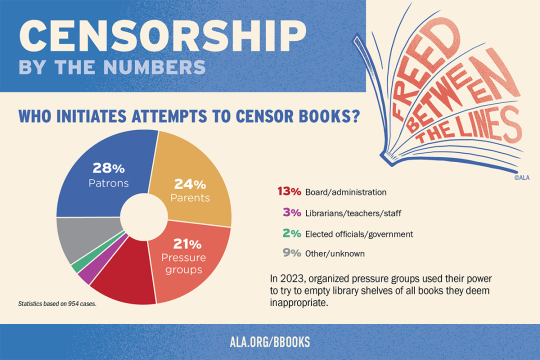


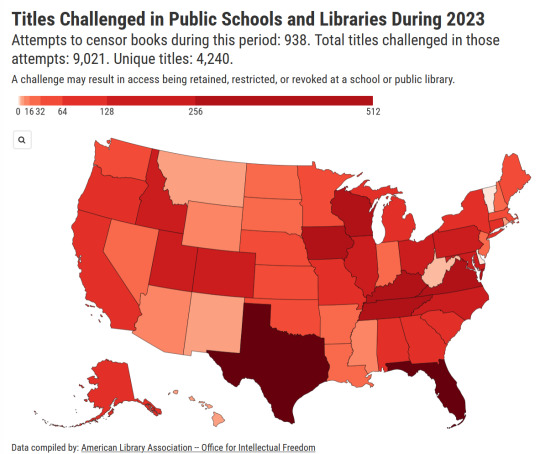
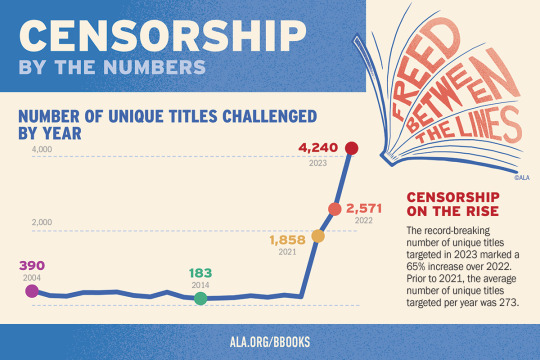
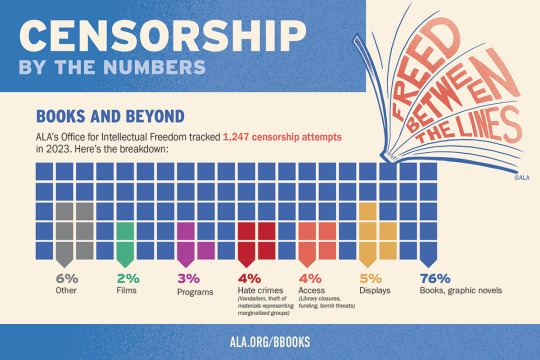
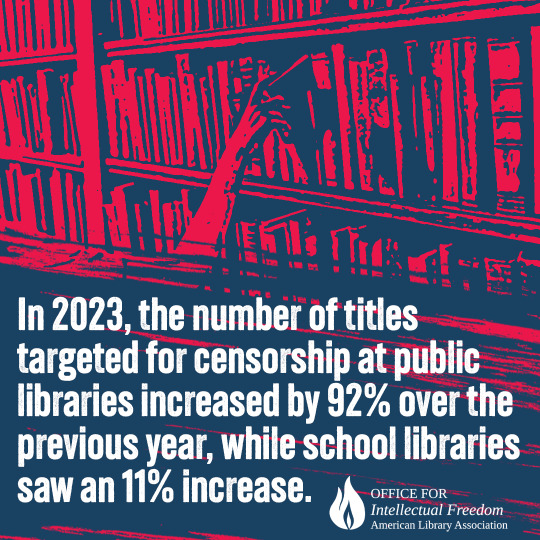


The ALA's State of America's Libraries Report for 2024 is out now.
2023 had the highest number of challenged book titles ever documented by the ALA.
You can view the full PDF of the report here. Book ban/challenge data broken down by state can be found here.
If you can, try to keep an eye on your local libraries, especially school and public libraries. If book/program challenges or attacks on library staff are happening in your area, make your voice heard -- show up at school board meetings, county commissioner meetings, town halls, etc. Counterprotest. Write messages of support on social media or in your local papers. Show support for staff in-person. Tell others about the value of libraries.
Get a library card if you haven't yet -- if you're not a regular user, chances are you might not know what all your library offers. I'm talking video games, makerspaces (3D printers, digital art software, recording equipment, VR, etc.), streaming services, meeting spaces, free demonstrations and programs (often with any necessary materials provided at no cost!), mobile WiFi hotspots, Library of Things collections, database subscriptions, genealogy resources, and so on. A lot of electronic resources like ebooks, databases, and streaming services you can access off-site as long as you have a (again: free!!!) library card. There may even be services like homebound delivery for people who can't physically come to the library.
Also try to stay up to date on pending legislation in your state -- right now there's a ton of proposed legislation that will harm libraries, but there are also bills that aim to protect libraries, librarians, teachers, and intellectual freedom. It's just as important to let your representatives know that you support pro-library/anti-censorship legislation as it is to let them know that you oppose anti-library/pro-censorship legislation.
Unfortunately, someone being a library user or seeing value in the work that libraries do does not guarantee that they will support libraries at the ballot. One of the biggest predictors for whether libraries stay funded is not the quantity or quality of the services, programs, and materials it offers, but voter support. Make sure your representatives and local politicians know your stance and that their actions toward libraries will affect your vote.
Here are some resources for staying updated:
If you're interested in library advocacy and staying up to date with the challenges libraries are facing in the U.S., check out EveryLibrary, which focuses on building voter support for libraries.
Book Riot has regular articles on censorship attempts taking place throughout the nation, which can be found here, as well as a Literary Activism Newsletter.
The American Library Association's Office for Intellectual Freedom focuses on the intellectual freedom component of the Library Bill of Rights, tracks censorship attempts throughout each year, and provides training, support, and education about intellectual freedom to library staff and the public.
The Electronic Frontier Foundation focuses on intellectual freedom in the digital world, including fighting online censorship and illegal surveillance.
I know this post is long, but please spread the word. Libraries need your support now more than ever.
163 notes
·
View notes
Text
I know we (rightfully) give Attack of the Clones a lot of grief for Obi-Wan just being able to show up unannounced and for him to just be given the literal biggest state secrets possibly of the entire war, in addition to how this cloning operation has been going on for like a decade without anyone knowing anything or any documentation crossing Mace Windu’s desk, but considering Sifo Dyas or Dooku or whoever was able to somehow erase an entire planet from (allegedly) every known bit of data collection or documentation, it could be argued that maybe Dyas and Dooku were just master forgers and had fake correspondence and reports going between them and the Kaminoans for over a decade now.
It’s not that far of a leap to say they got their hands on some heavily encrypted software on some very expensive computers and were able to imitate different speech patterns and documents and handwriting and official stamps or even holograms and holocalls. As far as the Kaminoans know, all of their contacts are fully aware and in the know about this clone army (because as far as they know, Sifo Dyas is alive and had to have been in communication recently)— When Obi-Wan shows up, it just happened to be at the exact time Dooku was the one supposed to be there in person himself that day. The Kaminoans did greet him as Master Jedi and said he was expected.
Obviously that could have only worked in the movie if Dooku had shown up and we saw him having to keep his cool/sneak around when some other Kaminoans tell him his “assistant” has already arrived, would you like us to escort you to him?
Internally Dooku’s thinking “WHOMST??” but externally he’s keeping his chill while searching the Force for whoever else might be— is that OBI-WAN KENOBI??
It’s soooooo tasty for Qui-Gon’s master and Qui-Gon’s apprentice to meet under these circumstances. Both of them know the other shouldn’t be there right now. They’re both having to play it cool in front of the Kaminoans, and this is even besides the fact Kenobi was there to find the bounty hunter assassin in the first place.
“I didn’t think you… were still as active in the Order,” Obi-Wan says slowly and diplomatically, knowing for a FACT that Dooku left the Order a long time ago.
“I… retired from active service,” Dooku says, equally diplomatically. “I act as a… consultant from time to time.”
“It’s soooo funny how I’ve never heard anything about that or this clone army the Jedi ordered,” Obi-Wan says, making direct eye contact with Dooku and probably trying to read his mind (to no avail). “The one they ordered ten years ago before there was ever any thought of the Jedi being actively involved on the frontlines of what isn’t a declared war. What would the Jedi want with a military in the first place?”
“How old are you, young one?” Dooku deflects in that fake kindly condescending grandfatherly voice. “How long have you been on the Council— Oh you’re just a Kniiiiight, that’s right, okay I see. How interesting. How much information are you actually privilege to, Obi-Wan?”
And this is all happening even before Obi-Wan Nancy Drew’d his way to Jango Fett’s private quarters!
Obi-Wan KNOWS he can’t go rogue right now when he’s that far from his ship on a city surrounded by an ocean and a literal army of clones soldiers (of that one super efficient bounty hunter, whenever it is he finds that out) all apparently under the command (?) of someone who definitely definitely super should not be speaking or doing or ordering anything under the name of the Jedi Order.
Count Dooku (who he doesn’t even know is a Sith yet) could very easily accuse him of being an impostor and have him detained or attacked or killed on sight. Zam Wessel was already established to be a shapeshifter in this movie, so it’s not outside the realm of possibility for Obi-Wan to not be who he says he is (which is kinda true?? since he WASN’T the Jedi ambassador for the Temple there to pick up his to-go order of a quarter-million identical men, with a million more on the way??). The Kaminoans might not even know much else about Jedi and Sith aesthetics besides “Wears robes” so if Dooku pulled a red lightsaber it might not even faze them, since he’d be able to provide more information and correspondence proving he’s the ‘actual’ Jedi anyway
Like can you imagine a fight breaking out not just between Kenobi and Jango, but a team-up of Jango and Dooku against Kenobi? That would have jumpstarted some of this clone army business a lot earlier in the movie and actually addressed what should have been the biggest conspiracy, coverup, and militaristic move of the MILLENNIUM
#AND— OH NO WHAT’S THIS?!#IT’S A PREQUEL POST WITH A STEEL CHAIR#Obi-Wan Kenobi#Attack of the Clones#Long post#Count Dooku#the clones#prequel trilogy#Star Wars prequel trilogy#I can’t remember my tags#Star Wars AU#Basically my biggest opinion of the prequel trilogy is really that if it was supposed to be about the clone wars#They should have already set all of the movies in the Clone Wars#I think we could have gotten a more effective and evocative story with Anakin and Amidala and Kenobi AND people most prominently involved#Without needing to see how the three of them ended up becoming The Main Characters#Like if you really wanted me to care about Order 66 you need to have made all of these characters and moving parts more prevalent in the nar#*narrative#You still could have developed the biggest character traits of each of them and had the events that lead to Anakin’s betrayal happen#and in that more focused narrative we would have actually felt the tragedy and horror that Order 66 should have evoked#for the entire audience#Not just the people who had seen several seasons of a supplementary cartoon#Your story’s got to be able to stand on its own legs#Watching RotS doesn’t give me anything to care about when it comes to the clones or their relationships with the Jedi or even all the other#Jedi who are killed too. Like besides Anakin marching on the temple and us seeing the implication that he just kills a bunch of children#We don’t actually have any established material within the movies to makes us care about the Jedi and the clones and the war itself#The war just feels like a backdrop instead of the driving action#anyway I don’t actually have a concise fix-it suggestion for the prequel trilogy like I did with TPM#… yet#I just like the thought of Kenobi and Dooku accidentally crossing paths and kicking off the action sooner#Better than a bunch of boring hallway talks
32 notes
·
View notes